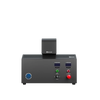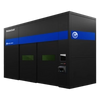Deep welding (Keyhole)
This type of welding is used when you want to obtain very deep seams (up to a few centimeters), using the phenomenon called “Keyhole”. This phenomenon is based on using the creation of steam and plasma that generates the heat of the laser radiation to create a deep capillary flow that is able to penetrate and weld deeply. This flow, being able to be directed, creates a weld bead which then cools down on the back from the displacement. The joint that is created is homogeneous and with optimal sealing characteristics. By exploiting the Keyhole technique it is possible to penetrate up to 10 times deeper than a normal laser welding and with much higher welding speeds.
Welding with galvo head
The welding technique with Galvanometric Head (Scanner) is the most precise and fastest that can be obtained with the Laser. The weld seam is really tight (even below the millimeter) and the agility of movement allows very complex welding profiles. However, the welding fields remain limited in the order of 10-20 cm after which they require displacement with moving axes or with robots (Weld on the fly), thus being able to make markings on wider fields or on 3D profiles.
Soldering
Soldering is a particular joint of two parts made of the same material, exploiting the fusion of a wire of different binder material. The latter, having a lower melting temperature than the pieces to be joined, is actually the only material that is melted and which, penetrating by capillarity into the gap between the two edges to be welded, is able by diffusion to bond with the heated walls and create a strong joint. Some binding materials used for brazing are Copper and Zinc. A feature of brazing is that it generally creates smooth, rounded weld profiles that typically do not require post-processing.
Overlay welding
Overlay welding is a technique mainly used for the repair of molds, tools and mechanical parts in general.
This type of welding can be manual, with an operator who directly manages a wire of material typically between 0.1 and 0.6 mm. In welding with automated overlay there is a feeder on the head which automatically manages the wire or the powder and which is deposited using automations. In both cases, Argon filler gas is used at the tail of the weld to avoid oxidation. Once the carryover activities are finished, the finishing is carried out in which the piece is mechanically milled and grinded to bring it back to its original size.
Laser Hardening
Laser Hardening is a thermal process that uses the laser to heat a metal to below its melting temperature and then cool it abruptly to change its chemical-physical characteristics. In particular, temperatures between 900 and 1400 ° C are reached and the carbon bonds change their shapes and geometries. The cooling, which can be spontaneous (self-hardening) or externally induced, prevents the carbon atoms from returning to their original places in the lattices and therefore allows the metal to be given characteristics of hardness and resistance higher than the original ones.
Unlike induction or fire hardening, laser hardening has no contact surfaces and has the precision with which the treatment can be done as a major advantage. This feature makes it perfect for tools or for small and complex parts where the parts to be hardened are limited in space. The thicknesses that are usually adopted range from 0.1mm to about 2mm in depth.
Furthermore, another advantage is that the amount of heat required is very low and concentrated compared to other methods and therefore there is energy saving and deformation of the pieces reduced to a minimum.
The digital nature of laser management makes laser hardening perfect for the flexibility of hardening paths and process parameters that can easily be varied.
Cladding Laser
Laser Cladding is a coating welding technique that uses metal powder filler material. The applications of this technique are the repair and deposition of coatings and surface layers on specific pieces, for example on tools, guides or other mechanical components that often have to respond to high characteristics of resistance to heat or mechanical stress. Cladding systems consist of two main sub-systems: the dust management system, which serves to create a mixture of gas and dust and to send a flow of material into the nozzle (lateral or coaxial), directed towards the beam Laser. The second sub-system is the optical system formed by the Laser source (usually 1kW to 3kW fiber optic) and a delivery laser head. The laser beam hits the surface of the metal and creates the weld pool, the nozzle directs the filler powder mixture which is integrated and welded upon cooling. A further smoothing pass without filler can serve as a finishing touch to the work. The whole process must take place under the use of inert gas.







![]()

![]()

![]()

![]()

![]()

![]()

![]()

![]()

![]()

![]()

![]()

![]()










